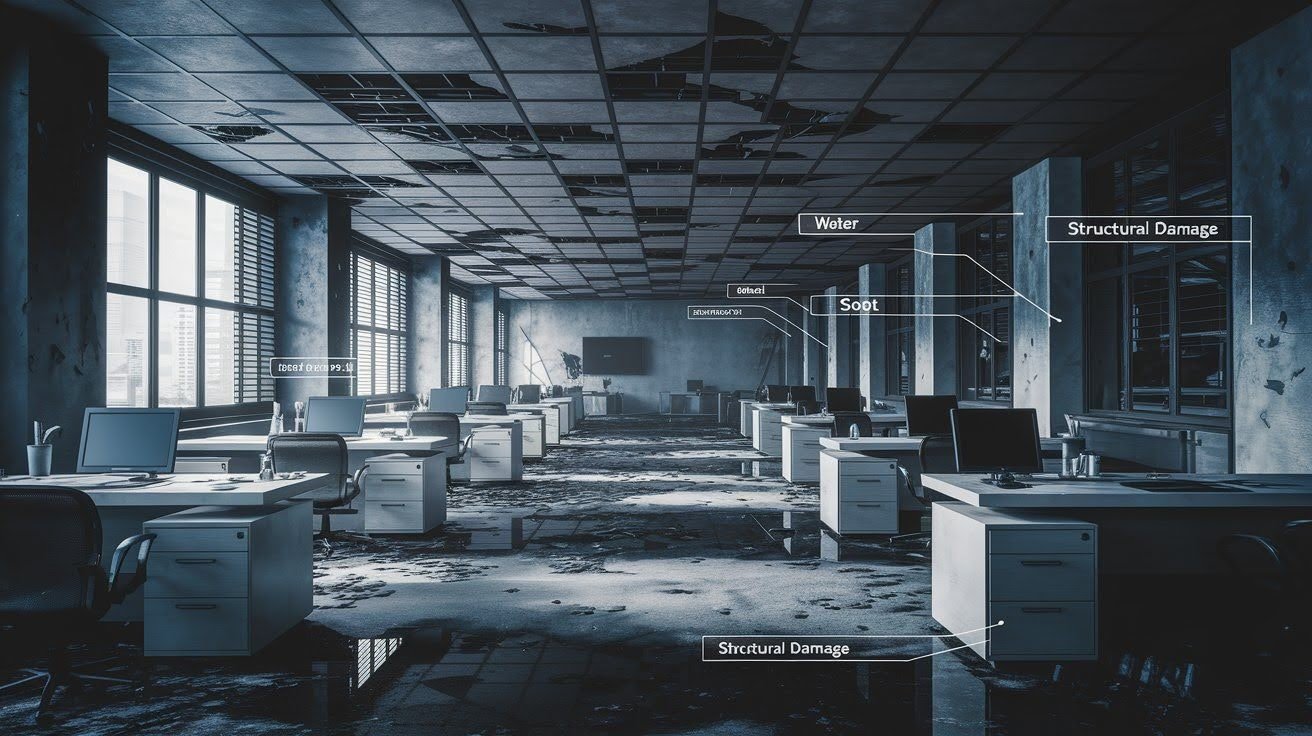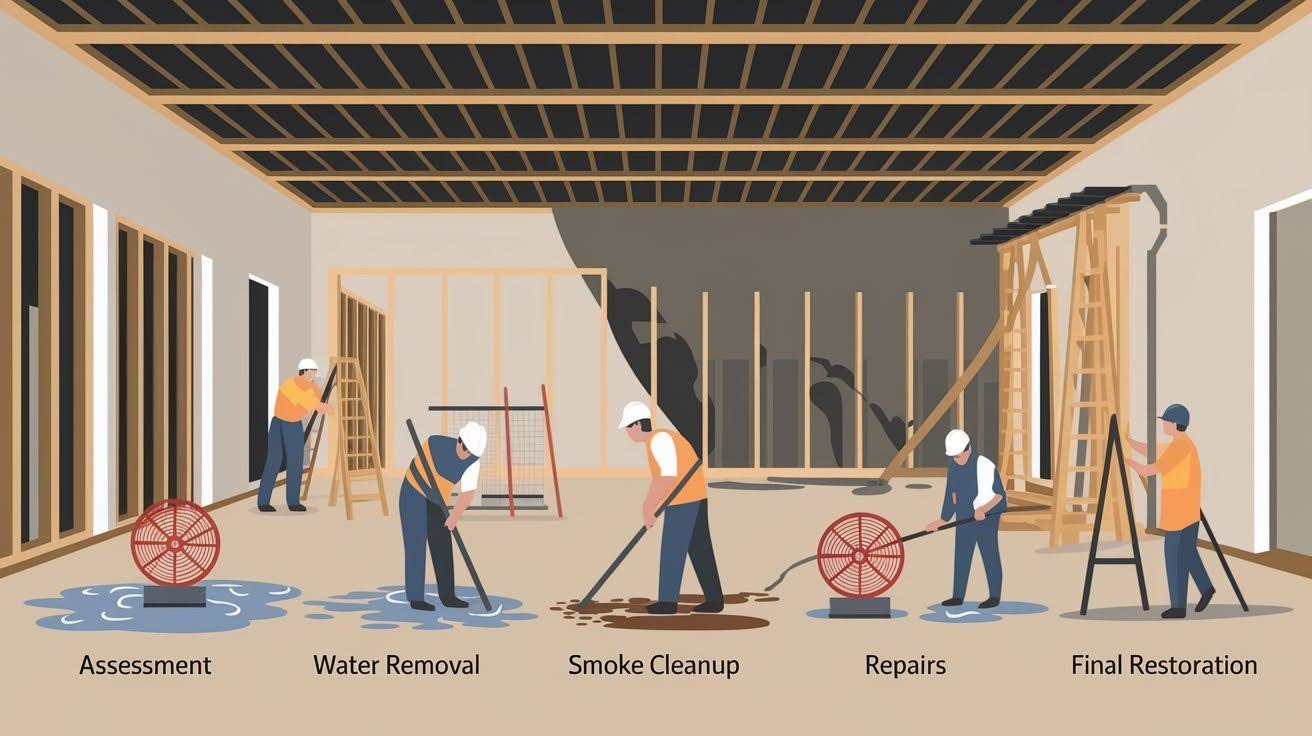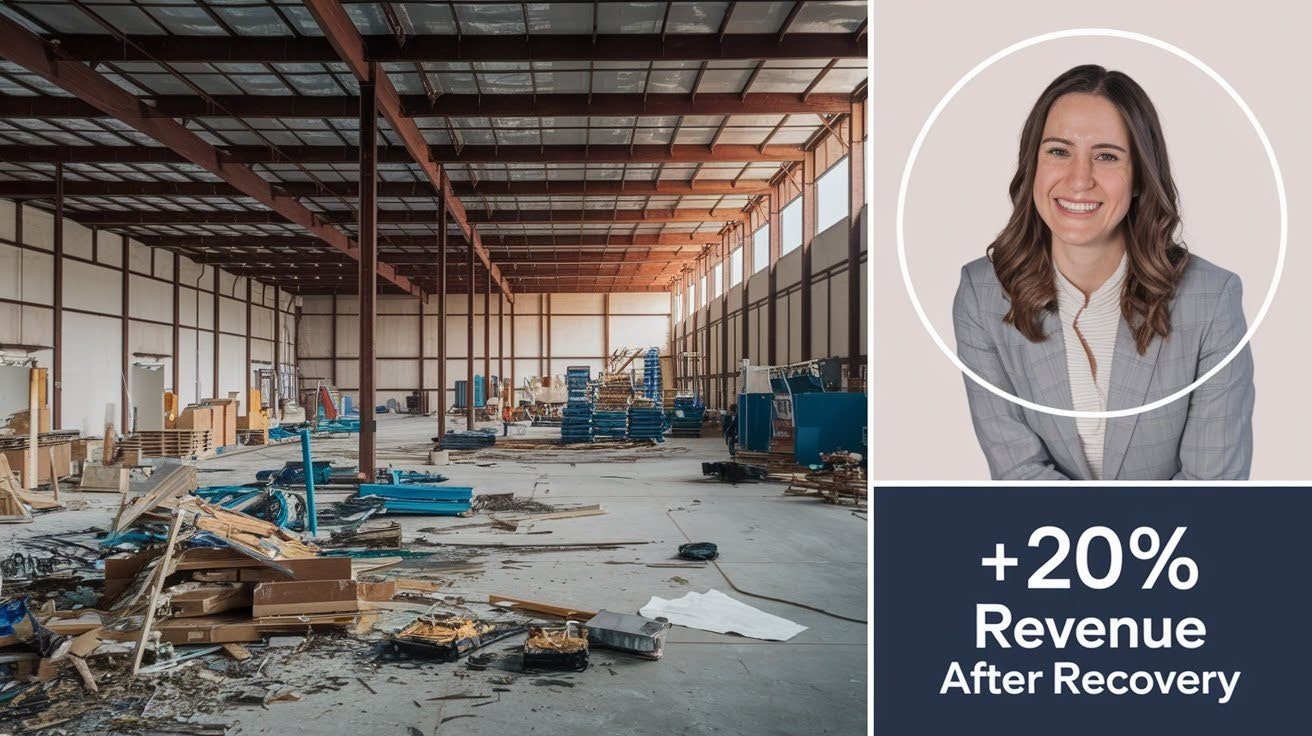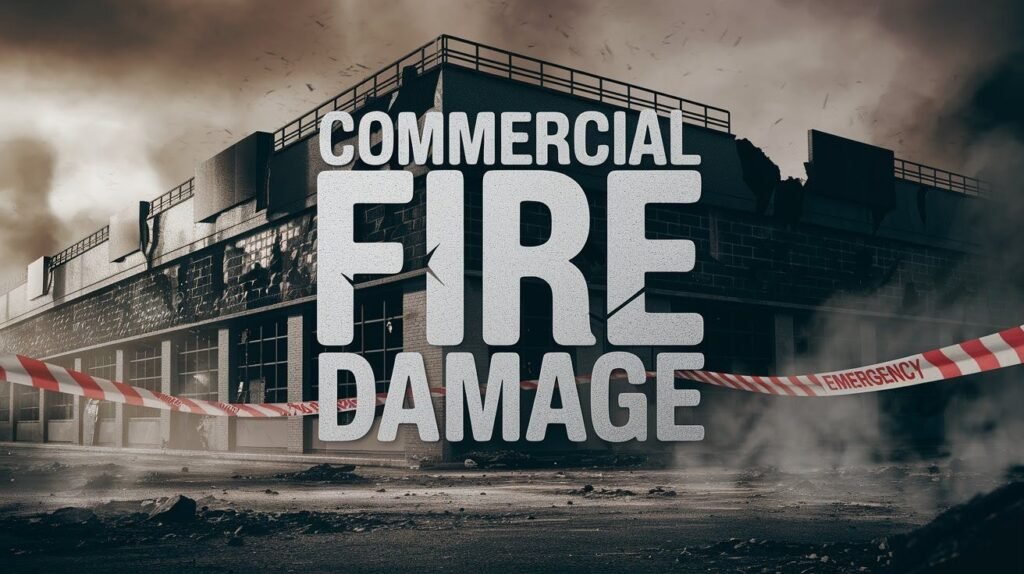Fire just hit your business. Your heart is racing. Your mind is spinning with questions. What happens next? I’ve helped hundreds of business owners in this exact situation. The path forward is clearer than you think.
This guide covers everything you need to know about commercial fire damage recovery. You’ll learn what to do right now, how repairs actually work, and what insurance covers. I’ll show you how to pick the right people and stop future fires.
Most importantly, you’ll learn how to get your business back on track.
Here’s the truth: most businesses come back stronger after proper repairs. The companies that struggle are those who don’t know what to do first.
You’re about to learn the system that works. No guessing. No costly mistakes. Just clear steps that protect your business and speed up recovery.
Your comeback starts now.
What Is Commercial Fire Damage?

Commercial fire damage affects any business building or property. It’s more than just burned walls and equipment.
Fire damage includes:
- Damage to walls, floors, and roofs
- Smoke damage throughout the building
- Water damage from firefighting efforts
- Soot buildup on surfaces and equipment
- Electrical system damage
- HVAC contamination
Here’s what surprises most business owners: smoke and water often cause more damage than the fire itself. Your building might look fine from outside. But inside? Smoke particles go everywhere. They get into walls, equipment, and inventory.
Water damage makes things worse. Firefighters use thousands of gallons to stop flames. This water soaks into everything it touches.
Immediate Steps After a Commercial Fire

Time matters after a fire. Every hour you wait costs more money.
Step 1: Make Sure Everyone’s Safe
Don’t enter the building until fire officials say it’s okay. Buildings can fall without warning. Electrical dangers are everywhere.
Step 2: Call Your Insurance Company
Call within 24 hours. Most policies require quick notification. Take photos and videos of everything.
Step 3: Protect Your Property
Board up windows and doors. Put up temporary fencing if needed. This stops theft and more damage.
Step 4: Record All Damage
Take photos of everything. Make detailed lists of damaged items. Save all receipts for temporary expenses.
Wait – don’t throw anything away yet. Your insurance person needs to see everything first.
Step 5: Contact Employees and Customers
Send updates about your status. Let them know when you’ll reopen. This keeps trust during recovery.
The Fire Damage Restoration Process Explained

Professional restoration follows a proven system. Here’s how it works:
Assessment and Planning (Day 1-2): Experts look at every inch of your property. They test air quality and check if the building is safe. You’ll get a detailed plan.
Water Removal and Drying (Day 2-5): Big pumps remove standing water. Powerful fans and dehumidifiers dry everything out. This stops mold from growing.
Smoke and Soot Cleanup (Day 3-10): Special equipment removes smoke particles from air. Workers clean soot from all surfaces. They use different products for different materials.
Building Repairs (Week 2-8): Contractors rebuild damaged walls and floors. They replace electrical systems and heating units. All work meets current building codes.
Final Restoration (Week 6-12): Your space gets painted and finished. New flooring goes in. Equipment gets cleaned or replaced.
The timeline changes based on how bad the damage is. Small fires might take 4-6 weeks. Major damage can require 6 months or more.
Working with Insurance After a Fire
Insurance claims seem overwhelming. But you can make the process easier.
Business property insurance covers building damage. It also covers equipment and inventory. Business interruption insurance pays for lost income during closure. Your insurance company assigns someone to help. They look at damage and guess costs. Be there during their visit.
Answer their questions honestly. Give them all requested papers quickly. Keep Detailed Records.
Track all expenses related to the fire. This includes:
- Hotel costs for workers who can’t work
- Equipment rental fees
- Extra operating expenses
- Lost inventory value
- Customer notification costs
These professionals work for you, not the insurance company. They can help get you more money. Typical fees are 10-15% of your claim. Insurance companies often make first offers below actual costs. Don’t accept the first offer right away. Review everything with professionals.
Choosing the Right Fire Damage Restoration Company
Not all restoration companies are the same. Your choice affects recovery time and costs.
Look for These:
- IICRC certification
- 24/7 emergency response
- Local business license
- Proper insurance coverage
- BBB rating
Ask These Questions:
- How quickly can you start?
- What’s your estimated timeline?
- Do you work directly with insurance?
- Can you give me references?
- What equipment do you use?
Watch Out For:
- Door-to-door salespeople
- Demands for full payment upfront
- No local office or references
- Really low estimates
- No written contracts
Get multiple estimates. But remember – the lowest price isn’t always best. Quality matters more than savings.
How to Fireproof Your Business Going Forward
Prevention costs less than recovery. Smart planning protects your investment.
Modern systems do more than sound alarms. They can:
- Automatically call fire departments
- Send alerts to your phone
- Monitor air quality
- Control ventilation systems
Maintain Fire Systems. Sprinkler systems need yearly checks. Replace old fire extinguishers regularly. Test emergency lighting monthly. Create Safe Space. Keep flammable materials away from heat sources. Store chemicals properly. Keep electrical panels clean.
Train Your Staff. Employees should know evacuation routes. Practice fire drills every three months. Give specific jobs during emergencies. Update Your Insurance. Review coverage yearly. Business values change over time. Make sure limits match current replacement costs.
Make Emergency Plans. Create detailed response procedures. Include contact lists for employees and vendors. Store copies offsite and online.
Cost of Commercial Fire Damage Restoration
Restoration costs vary widely. Several factors affect your final bill. Small office fires might cost $20,000-50,000 to restore. Large warehouse fires can exceed $500,000. Restaurants face higher costs due to grease damage. Manufacturing facilities need special equipment replacement.
Older buildings often require code upgrades during restoration. This adds big costs.
Typical Cost Breakdown:
- Water removal and drying: $3-7 per square foot
- Smoke cleanup: $5-10 per square foot
- Building repairs: $15-50 per square foot
- Contents cleaning: $2-8 per item
- Equipment replacement: Varies widely
Act quickly to minimize damage. Work with preferred insurance vendors. Get multiple bids for major work. Think about temporary solutions while planning permanent repairs. Sometimes you can reopen partially during restoration.
Case Study: Business Recovery After Fire

Let me share Sarah’s story. She owned a small manufacturing company in Ohio.
An electrical fire started in her office area one Tuesday night. Sprinklers contained the flames. But smoke damaged the entire 8,000 square foot facility. Sarah called her insurance company within hours. She hired a restoration company that same day. Her quick action stopped mold from growing.
Water removal took 3 days. Smoke cleanup required 2 weeks. Rebuilding the office took 6 weeks total. Sarah’s insurance covered $180,000 in damages. Business interruption insurance paid $45,000 for lost income.
“I wish I’d updated my coverage limits,” Sarah told me. “Business had grown, but insurance hadn’t.” She also learned the value of good records. Detailed inventory lists sped up her claim process.
Sarah reopened stronger than before. New equipment improved efficiency. Updated safety systems gave her peace of mind.
Her revenue actually increased 20% in the year following the fire.
Moving Forward After Fire Damage
Fire damage feels overwhelming at first. But businesses recover every day.
The key is taking action quickly. Work with experienced professionals. Stay organized throughout the process. Your business can come back stronger. Better systems, updated equipment, and improved safety measures often result from proper restoration.
Remember, you’re not alone in this process. Insurance people, restoration professionals, and contractors are there to help.
Focus on one step at a time. Before you know it, you’ll be back in business.
Conclusion
Commercial fire damage feels scary at first. But you now have the steps to get back on track.
Take action quickly. Contact your insurance company today. Secure your property right away. Take photos of everything you see. The restoration process is straightforward. Professional teams handle the hard work. Your job is picking the right people and staying organized.
Remember Sarah’s story. Her business came back stronger after the fire. Your business can too. Insurance covers more than most owners think. Work with people who know the system. Keep records of what you spend.
Good safety systems protect your future. Update them regularly. Train your workers properly. Recovery takes time but it works. Thousands of businesses rebuild successfully every year. You have what you need to join them.
Your fresh start begins with one phone call. Don’t wait another day.
Frequently Asked Questions
How long does commercial fire damage restoration take?
Small fires usually need 4-6 weeks to fix completely. Big damage can take 6 months or more depending on how much it needs rebuilding.
Can I reopen my business during fire damage restoration?
Many businesses can partly reopen during repairs if safe areas exist. Your repair team will help decide which parts can work safely.
Does insurance cover lost business income during restoration?
Business interruption insurance pays for lost money while your business stays closed for repairs. You need to add this coverage to your policy first.
What’s the difference between fire damage and smoke damage restoration?
Fire damage means rebuilding burned parts and replacing equipment. Smoke damage needs special cleaning to remove particles from air, walls, and items throughout the building.
Should I hire a public adjuster for my commercial fire claim?
Public adjusters work for you instead of the insurance company and usually increase settlements by 10-40%. They charge 10-15% of your final claim money.


